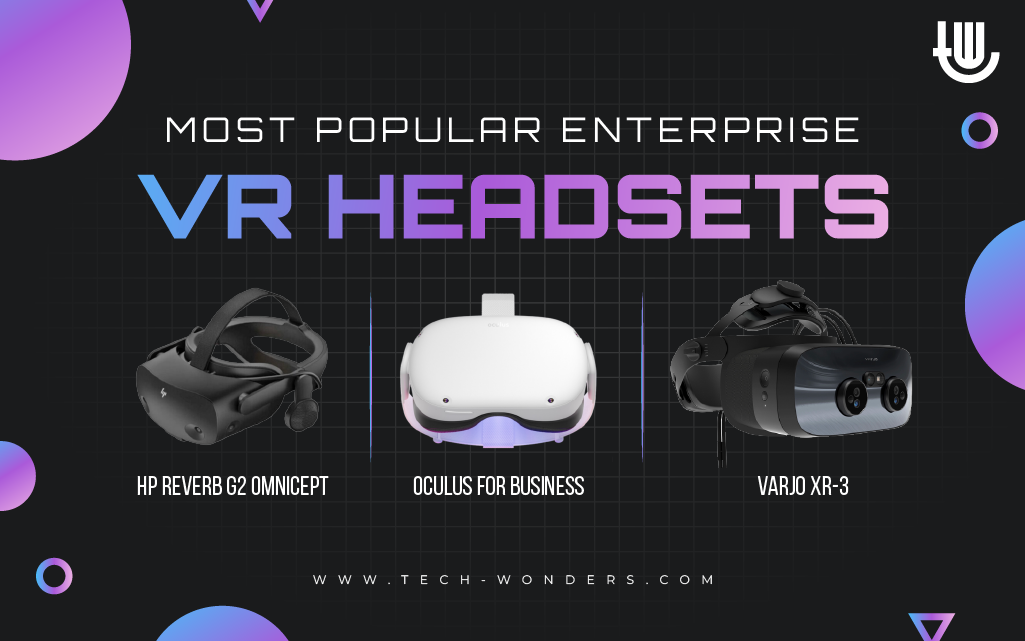
Virtual reality (VR) technology has rapidly evolved in recent years, and with that, there has been a proliferation of VR headsets on the market. While the majority of VR headsets are aimed at gamers, there is also a growing market for enterprise VR headsets that are designed for business use cases such as training, simulation, and visualization. As a business owner, choosing the right VR headset for your enterprise can be challenging. This article will give you a VR headset comparison of some of the most popular enterprise VR headsets to help you make an informed decision.
Oculus for Business
The Oculus for Business is a standalone VR headset designed for enterprise use. It offers a high-quality VR experience with a resolution of 1600 x 1440 pixels per eye, a 72Hz refresh rate, and a 110-degree field of view. The headset also includes features such as built-in audio, inside-out tracking, and hand controllers, which make it easy to use and comfortable for long sessions.
One of the key advantages of the Oculus for Business is the platform’s versatility. The headset can be used for a range of enterprise applications, from training and simulation to collaboration and visualization. It also has a wide range of compatible software and tools, making it a flexible solution for businesses of all sizes.
The Oculus for Business is also highly secure, with a range of features designed to protect user data and maintain privacy. For example, the headset includes a kiosk mode, which restricts access to specific applications and content, and an enterprise-grade mobile device management (MDM) system, which allows administrators to remotely manage and update headsets.
Another advantage of the Oculus for Business is its affordability. At $799, the headset is significantly cheaper than some of its competitors, making it an attractive option for businesses on a tight budget. The headset is also available in bulk quantities, with discounts offered for larger orders.
However, the Oculus for Business does have some limitations. For example, the headset is only compatible with the Oculus app store, which may limit the range of software and tools available to businesses.
HP Reverb G2 Omnicept
The HP Reverb G2 Omnicept is a high-end VR headset designed for enterprise use. It features a resolution of 2160 x 2160 pixels per eye, a 90Hz refresh rate, and a 114-degree field of view, providing a high-quality VR experience. The headset also includes eye-tracking and hand-tracking technology, which allows for more natural and intuitive interactions in VR environments.
One of the key advantages of the HP Reverb G2 Omnicept is its focus on biometric data. The headset includes sensors that can measure things like heart rate, pupil dilation, and facial expressions, which can provide valuable insights into how users are responding to VR experiences. This makes it an ideal choice for applications such as mental health therapy, where biometric data can be used to track progress and adjust treatment.
The HP Reverb G2 Omnicept is also highly customizable, with a range of accessories and options available to suit specific business needs. For example, the headset can be fitted with prescription lenses, or customized with a range of face cushions and straps for increased comfort. The headset is also compatible with a range of third-party software and tools, making it a flexible solution for businesses of all sizes.
Varjo XR-3
The Varjo XR-3 is a high-end VR and mixed reality (MR) headset designed for enterprise use. It features a resolution of 2880 x 2720 pixels per eye for VR content and a resolution of 1920 x 1080 pixels per eye for MR content, providing an incredibly sharp and detailed VR and MR experience. The headset also includes eye-tracking and hand-tracking technology, as well as passthrough cameras, which allow users to see the real world while still in VR.
One of the key advantages of the Varjo XR-3 is its ability to seamlessly transition between VR and MR. This makes it an ideal choice for applications such as product design and engineering, where users need to switch between virtual and real-world environments. The headset also includes support for a range of industry-standard software tools, making it a flexible solution for businesses in a range of industries.
The Varjo XR-3 also features a unique feature called ‘Varjo Workspace’, which allows users to create and manage their virtual workspace. This is particularly useful for complex tasks such as design and engineering, where multiple applications and tools may need to be used simultaneously.
However, the Varjo XR-3 is also the most expensive of the three headsets, with a starting price of $5,495. It is also relatively heavy, weighing in at 770g, which may make it uncomfortable for extended use.
Summing Up
Choosing the right enterprise VR headset for your business requires careful consideration of your specific use case and budget. The Oculus for Business, HP Reverb G2 Omnicept, and Varjo XR-3 are all excellent options for businesses looking to leverage VR technology for training, simulation, visualization, and other applications. By weighing the pros and cons of each headset, you can choose the one that best suits your needs and budget, and take advantage of the many benefits that VR technology can offer.
Ultimately, the choice of headset will depend on your specific business needs. If you are on a tight budget and need a versatile and secure headset, the Oculus for Business may be the best option. If you require biometric data for mental health therapy or other applications, the HP Reverb G2 Omnicept may be the right choice. And if you require seamless transitions between VR and MR and need a highly customizable headset, the Varjo XR-3 may be the best option.
Regardless of which headset you choose, VR technology can help your business to improve training, simulation, and visualization, and gain a competitive advantage in a range of industries.